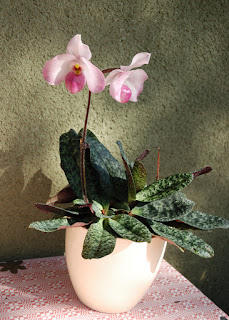Have I ever mention that I always wanted to have the beautiful Paphiopedilum Magic Lantern which reminds me so much of a chinese lantern in pink, with these gorgous vein and just soo incredabily exotic and attractive?
Well yeah, guess how this worked out for me. I got one, two years ago, it was bloody slow in growing - a year and a half of not doing anything just being there, then it had a new growth, then the new growth suddenly and without any reason died on me and then the old growth too. Delightful, till you actually go out to the world of internet and read from 70% of people who had this one plant that it's very prone to failure as aparently it has some problems.
So, after this lovely story let's get back to the point, being dissapointed in blooming my dream Magic Lantern i had to settle on not having it... till I came accross the Paphiopedilum Ho Chi Minh. Which in full fairness is a Magic Lantern on steroids.
Its beautiful, its vigorous, it blooms like mad, and it tends to have more than one flower. Bingo! I'm in love.
As a paphiopedilum lover I always look on two things flowers and foliage, because you need to love your orchids when they are in bloom and out of flower. With these beautiful mottled leaves it's hard to resist the charm! The foliage is dark green/blue with a lighter marbling and the leaves are covered in a hairy-like mesh. The foliage usually doesn't grow typically straight and it tends to swirl around the place adding to the charm.
They have exactly the same requirements as other paphiopedilum, treat it as paphiopedilum Maudiae Green and you are on the straight road to success. Water one a week, remember not allow it to be dry as paphiopedilum like moist medium, use a growth booster every other week and then a bloom boster when you notice a flower spike.
Well yeah, guess how this worked out for me. I got one, two years ago, it was bloody slow in growing - a year and a half of not doing anything just being there, then it had a new growth, then the new growth suddenly and without any reason died on me and then the old growth too. Delightful, till you actually go out to the world of internet and read from 70% of people who had this one plant that it's very prone to failure as aparently it has some problems.
So, after this lovely story let's get back to the point, being dissapointed in blooming my dream Magic Lantern i had to settle on not having it... till I came accross the Paphiopedilum Ho Chi Minh. Which in full fairness is a Magic Lantern on steroids.
Its beautiful, its vigorous, it blooms like mad, and it tends to have more than one flower. Bingo! I'm in love.
As a paphiopedilum lover I always look on two things flowers and foliage, because you need to love your orchids when they are in bloom and out of flower. With these beautiful mottled leaves it's hard to resist the charm! The foliage is dark green/blue with a lighter marbling and the leaves are covered in a hairy-like mesh. The foliage usually doesn't grow typically straight and it tends to swirl around the place adding to the charm.
I kind of jumped the gun, Paph. Ho Chi Minh is a child of Paphiopedilum vietnamense x delenatii 'Dunkel'. These two are know to be easy growers and strong performers when it comes to blooming. Joy to the gorwers. They will quickly, ok let's not exaggerate it's not oncidium, but fairly fast compared to other paphiopedilum orchids, grow into a substantial sized plant with more than one flower spike.
The flowers have a lot of characteristic which you could easilly point to oriental decoration and lanters, yes these pink (or white and pink) flowers do remind me of Chineese New year. The side petals tend to be quite big and slightly curles back, the pouch isn't as big as it usually is in other paphiopedilum. Furthermore depending on the amount of light you provide for your orchid the flowers will be much darker or close to white with a pink wash.
The best thing about this orchid is that is easily available, especially now it became very popular and thanks to many award it has received you can buy it in almost every orchid nursery! So start looking and grab it when you have the chance as you won't regret!
*
Some pictures presented in this article may not belong to me
and are a property of their respectable owners.




Comments
Post a Comment